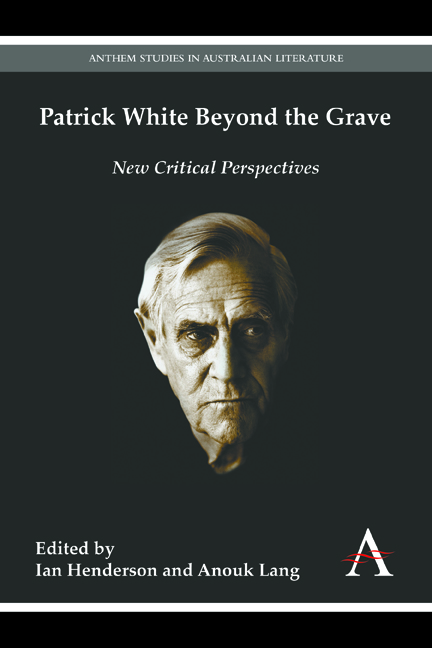Book contents
- Frontmatter
- Contents
- Acknowledgements
- Introduction
- Part I RESURRECTED PAPERS
- Part II MANY IN ONE
- Chapter 3 White's London
- Chapter 4 Elective Affinities: Manning Clark, Patrick White and Sidney Nolan
- Chapter 5 ‘Dismantled and Re-Constructed’: Flaws in the Glass Re-Visioned
- Chapter 6 Patrick White's Late Style
- Part III THE PERFORMANCE OF READING
- Part IV QUEER WHITE
- Contributors
- Index
Chapter 4 - Elective Affinities: Manning Clark, Patrick White and Sidney Nolan
from Part II - MANY IN ONE
Published online by Cambridge University Press: 18 January 2018
- Frontmatter
- Contents
- Acknowledgements
- Introduction
- Part I RESURRECTED PAPERS
- Part II MANY IN ONE
- Chapter 3 White's London
- Chapter 4 Elective Affinities: Manning Clark, Patrick White and Sidney Nolan
- Chapter 5 ‘Dismantled and Re-Constructed’: Flaws in the Glass Re-Visioned
- Chapter 6 Patrick White's Late Style
- Part III THE PERFORMANCE OF READING
- Part IV QUEER WHITE
- Contributors
- Index
Summary
Sydney 1959
Manning Clark and James McAuley were walking together along George Street in Sydney. They had walked half the distance when McAuley noticed a familiar face coming in the opposite direction – one which Clark would later claim haunted him for days afterwards – the face of ‘a man who wanted something which no human being could give him’. As their paths crossed, the three men halted to speak with one another. McAuley introduced Clark to Patrick White. It was the beginning of an intensely felt three-decade long friendship, one that flowered through Clark and White's mutual admiration for one another's work and journeyed unevenly from infatuation and love to disillusionment and acrimony. By 1959, White had already published three of his greatest works: The Aunt's Story (1948), The Tree of Man (1955) and Voss (1957). While White was at the height of his creative powers, Clark had barely managed to begin his life's major work. Aged 44 he was still three years out from publishing the first volume of A History of Australia. Unknown to both men, their creative paths were already connected through the inspiration they had drawn from artists such as Arthur Boyd and Sidney Nolan. Behind the story of White and Clark's deeply felt, tempestuous relationship then lies a much larger one: the struggle of a relatively small vanguard of intellectual and cultural ‘elites’ to create a new vision of Australia in the late twentieth century.
Canberra 1949
As Manning Clark moved to Canberra with dreams of writing what he called ‘the spirit of place’ into his history of Australia, Patrick White, preparing to write Voss, was reading the journals of the explorer Ludwig Leichhardt. In the same year, Sidney Nolan was flying over central Australia working on a series of paintings of the ‘MacDonnell Ranges’, ‘Ayers Rock’ and ‘unnamed’ ridges, sand hills and plains, flooded in what he called ‘a transparent floating light’. Nolan was also reading the diaries of Burke and Wills in preparation for the first of a stunning sequence of paintings based on their ill-fated attempt to cross the continent from south to north in 1860–61.
- Type
- Chapter
- Information
- Patrick White Beyond the GraveNew Critical Perspectives, pp. 81 - 100Publisher: Anthem PressPrint publication year: 2015



